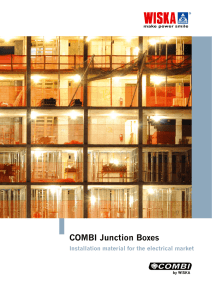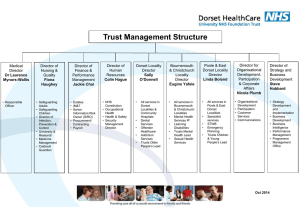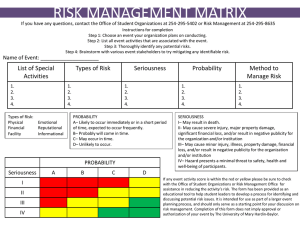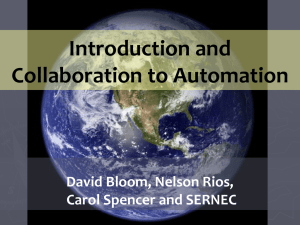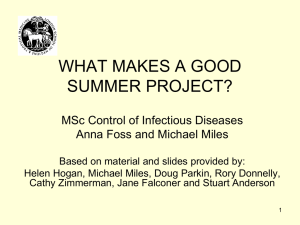sustainability of combi as community based intervention
advertisement
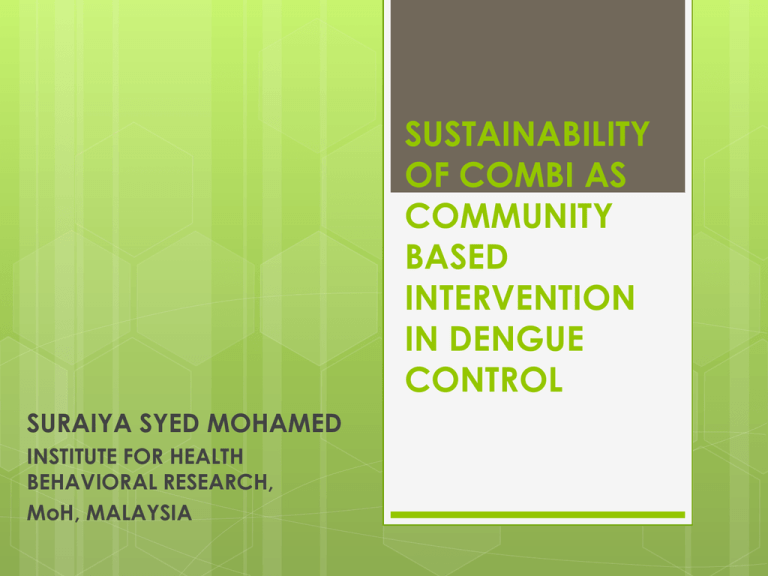
SUSTAINABILITY OF COMBI AS COMMUNITY BASED INTERVENTION IN DENGUE CONTROL SURAIYA SYED MOHAMED INSTITUTE FOR HEALTH BEHAVIORAL RESEARCH, MoH, MALAYSIA Introduction Research Q’s Methodology Key Findings Challenges Lesson Learned Recommendations RESEARCH HIGHLIGHT COMBI Methodology for planning sustained actions in communication and social mobilization (Lloyd LS 2006) Social Communication + Social Mobilization = Changes in behavior! COMBI was piloted in JB, Johore, Malaysia (2001). COMBI was expanded to all other states in Malaysia. As of 31 Dec 2010 - 1,625 locality implemented COMBI in Malaysia (MoH) This pilot project was basically successful in behaviour change in dengue control. Pilot project in Johor (Mohd Raili et al. 2004) Pilot project in Selangor (S Rozhan et al.2006) Expansion of COMBI as a community-based intervention in dengue control is proven to be effective i.e. shortterm success but the sustainability of COMBI in longterm remains an issue Factors that determine the success and failure of COMBI in a locality. Challenges in sustaining COMBI and the solution to overcome these challenges. Research Questions Conceptual Framework Study Designs & Population Study Sites & Samples Recruitment Methodology Instruments & Analysis Sustainability maintenance of activities and results after external financing and support has been withdrawn Conceptual Framework (US Agency for International Development 1988). Five integrated actions in COMBI which comprises of advocacy, social mobilization, publicity, interpersonal communication and point-of service promotion Assessing sustainability are clustered into 3 key categories; Conceptual Framework (Shediac-Rizkallah & Bone 1998) 1. maintenance of health benefits from the initial project 2. continued delivery of community activities 3.long term capacity building in the community Mix-method designs (Qualitative and Quantitative) Study Designs & Population IDIs - coordinators & chairmen FGDs- members (committees and promoters) FFIs -community Study Sites STATE Sarawak STUDY sites Tmn Malihah II Kg Bako Johore Pasir Gudang Kg. Melayu Majidee Kelantan Kg.Kandis Bachok Kg.Baru Nelayan Tumpat Penang Kg. Binjai Kg. Baru Sg. Ara Selangor Tmn Setia Klang Sg.Ramal Dalam Negeri Sembilan Tmn Tunku Jaafar Tmn Enstek 10 COMBI coordinators 14 COMBI chairmen 13 sessions of FGDs N=489 FFIs Samples Recruitment Semi-structured interview guide based on themes IDIs and FGDs was facilitated by computer software package, NVivo version 8.0. Instruments & Analysis Set of questionnaire – FFIs responses were analyzed using SPSS version 19.0. COMBI has succeeded in increasing the communities Key Findings : Health Benefits • knowledge on dengue and skills on source reduction activities COMBI have succeeded in controlling dengue Key Findings: Health Benefits DF incidences were decreased after implementing COMBI and much easier task to control dengue outbreak in the localities Communities had an indifferent attitude about eliminating Aedes breeding sites. Key Findings: Health Benefits Some are conscious about eliminating Aedes sites but the majority is not. Majority of the communities are not active partners in the control actions control efforts. Challenges They had transferred the responsibility to the health sector, local council and COMBI members while a small minority of the communities taking responsibilities of their own health. Publicity on large scale at local localities was only at initial stage and recently when COMBI was reactivated. Key Findings: Publicity Smaller scale publicity was still carried out in active localities after the discontinuation of financial support from health department. Gotong-royong was widely used compared to COMBI. Key Findings: Publicity Printed materials (banner) which is more visible were able to assist members in carrying out COMBI activities as the community was informed in advanced Community activities (family day, recreational, sports, competition) that involve the whole family and provide refreshments. In few localities, involvement from political assembly man was also able to attract the community. Key Findings: Publicity Attractions Discontinuation of COMBI publicity were perceived by the members as discontinuation of COMBI activities. Thus, the community is no longer concerned about dengue and this might affect source reduction activities. Challenges Active localities source reduction at community levels is still being conducted and even garnered cooperation from the community. Inactive localities source reduction activities are rarely conducted due to the lack of participation. Key Findings : Source Reduction Activities in DF control In most of the communities perceived gotong-royong as the responsibilities of health department and local authorities Challenges Therefore, certain areas are neglected such as no man’s land and public areas House visits, giving feedback during meetings and handing reports on COMBI activities to health department or local council Key Findings : Monitoring Activities COMBI members and chairmen felt that the monitoring activities should be the responsibilities of the coordinator Inactive localities there were coordinators that rarely go to the community and join community activities Key Findings : Monitoring Activities Active localities - one PHA to one locality was assigned to monitor closely the COMBI activities by the community. 1 PHA 1 COMBI Coordinator should monitored COMBI activities assisted by members and should avoid causing difficulty to the communities. Challenges Continuous involvement of coordinator is important in getting the support from the communities COMBI chairmen were committed and self-empowered but lack the skills to empower the community. Key Findings : Community Leaders Obstacles that refrain COMBI chairmen from being active migration, holding various portfolios, opposing political views and feeling unappreciated. Coordinator - interest and liking in community work resulted in committed and less committed coordinators, which could be associated with active and inactive localities and the sustainability of COMBI in those localities. Key Findings : Coordinators Leadership Leaders did not manage the concept of ‘bottom-up community participation’. Challenges Hindrance to the sustainability of COMBI - Changes in administration which referring to health department and political structure in the community Key Findings : Members Participation Active localities - they were empowered ; identify problem, analyze situations, planning, implementing and assessing activities. Applied strategic comm & beh. change approach Inactive localities they were very much dependent on the MoH instructions for actions which reflected lack of empowerment. Key Findings : Communities Participation Active localities which were mostly suburban, the communities’ involvements were better because of their bonding with COMBI members and felt obliged to participate. The communities were cooperative and had showed interest in source reduction . Inactive localities which were mostly urban, the majority of the communities were not corporative, difficult to accept change and have no interest in the subject Key Findings : Communities Participation Some communities were relatively easy to work with, while others were more difficult Informants viewed dengue as a disease of interest but only when there were cases in the community Challenges In the active locality, the multi-level commitment . was very much higher compared to the nonactive locality. However, commitment from corporate agencies were lacking and need to be explored. Challenges : Advocacy /Multilevel Commitment Proper training on COMBI - skills on mobilizing the community at all stages is extremely important and also should be conducted from time to time because of the turnover among the coordinators, chairmen and members. Lesson Learned: Training Efforts led by “program champions” have substantial prospects for initial success, but shared authority and responsibility among several or many offer better prospects for long-term success (Elder J. 2005). Lesson Learned: Leadership Apprentices among members should be appointed in order to sustain the continuity of COMBI Lesson Learned: Publicity Publicity on COMBI should be emphasized and creatively inserted through community program, which could be more meaningful and should be led by community leaders with good communication skills. It is conceivable that the regular repetition of COMBI message and publicity is necessary to ʻkeep the flame alive’ in the community (Rozhan 2006). Monitoring activities by the members and coordinators must meet a mutual understanding and agreed upon by both parties. Continuous monitoring is extremely important to achieve sustainability. Lesson Learned: Monitoring Lesson Learned: Partnerships Community need to be involved actively in dengue control and to strengthen partnerships between the community, health staff especially Vector Control Unit and Health Education Unit who involved directly in COMBI, others government agencies and corporate bodies. Dengue and COMBI education should be continuous and early education is substantial Recommendation from Informants Committed and dedicated leaders, updated knowledge and skills, continuous publicity on COMBI and designated budget are important to sustain COMBI. Recognition is important as identification to COMBI members and make them proud hence motivate them and others to join COMBI. Recommendation from Informants Priority services in medical, icon or spokesperson for COMBI, study visits, top ratings for outstanding COMBI members. Members should be trained on participatory methods. This includes selffunding and built networking with other agencies. Strengthen COMMUNITY skills Recommendation from Research Team Capacity to plan, administer, implement and monitor at all levels. Experience in behavioural change, communication and social mobilization. Strengthen STAFF skills Recommendation from Research Team 1. Absence of early and active planning 2. Many programs see their funds withdrawn before activities have reached full fruition 3. Programs that were abruptly or inappropriately terminated Points to ponder (Goodman & Steckler, 1987/88)


